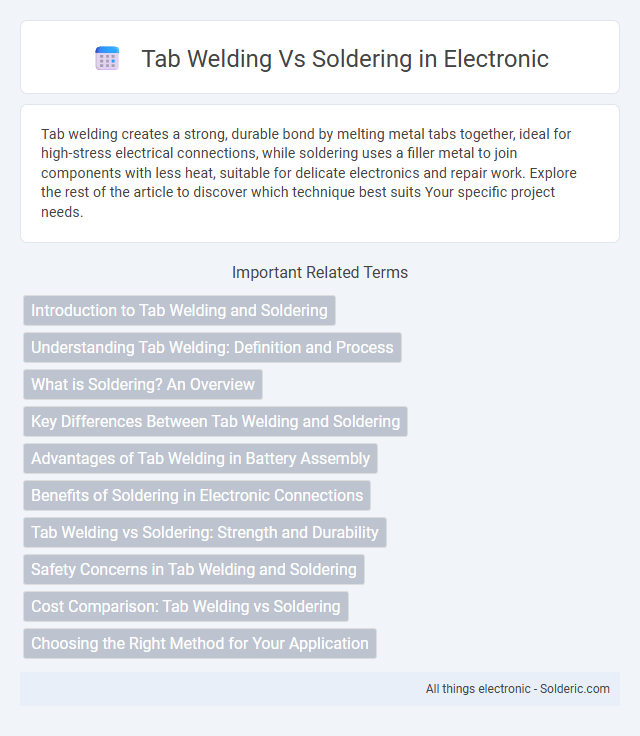Tab welding creates a strong, durable bond by melting metal tabs together, ideal for high-stress electrical connections, while soldering uses a filler metal to join components with less heat, suitable for delicate electronics and repair work. Explore the rest of the article to discover which technique best suits Your specific project needs.
Comparison Table
| Aspect | Tab Welding | Soldering |
|---|---|---|
| Definition | Joining metal tabs by localized heating and pressure | Joining metals by melting a filler metal (solder) at low temperature |
| Temperature | High (above 1000degC) | Low (180degC - 250degC) |
| Materials | Metals like steel, aluminum tabs | Various metals, often copper or electronics components |
| Strength | Strong mechanical and electrical connection | Moderate mechanical strength, good electrical conductivity |
| Applications | Battery packs, metal sheet assembly | Electronics, circuit boards, plumbing |
| Process Speed | Fast, automated friendly | Slower, manual or semi-automated |
| Equipment | Spot welders, resistance welders | Soldering irons, reflow ovens |
| Heat Effect | Localized, minimal distortion | Broader heat spread, potential component damage |
| Environmental Impact | Low emissions, energy efficient | Use of flux, potential fumes |
Introduction to Tab Welding and Soldering
Tab welding joins metal tabs to surfaces using electric resistance heat, creating strong, conductive bonds ideal for battery packs and electronics. Soldering melts a metal alloy to fuse components, providing precise, low-temperature connections common in circuit boards and delicate assemblies. Understanding these methods helps you select the best technique for durability and electrical performance in your projects.
Understanding Tab Welding: Definition and Process
Tab welding is a resistance welding process that joins thin metal strips, or tabs, to a base metal by applying pressure and electric current to create a localized heat fusion. This technique ensures a strong and durable bond without melting the entire base material, making it ideal for battery pack assembly and electrical connections. The process involves precise control of welding parameters such as current, pressure, and time to achieve optimal weld quality and minimize thermal distortion.
What is Soldering? An Overview
Soldering is a metal-joining process that uses a filler metal with a lower melting point than the base materials to create a strong electrical and mechanical bond without melting the workpieces. This technique is widely used in electronics and plumbing to connect components with precision and minimal heat distortion. Your choice between tab welding and soldering depends on factors such as conductivity, joint strength, and application requirements.
Key Differences Between Tab Welding and Soldering
Tab welding uses high electrical current to fuse metal pieces directly, creating a strong, conductive bond ideal for battery packs and electrical connections. Soldering involves melting a filler metal with a lower melting point than the base materials to join components, providing a mechanical and electrical connection without melting the workpieces. Tab welding offers superior strength and conductivity, while soldering provides flexibility for delicate electronics and easier rework.
Advantages of Tab Welding in Battery Assembly
Tab welding in battery assembly offers superior electrical conductivity compared to soldering, ensuring efficient current flow and reduced resistance. It provides stronger mechanical bonds, enhancing durability and vibration resistance crucial for battery performance and safety. This method also avoids heat damage to sensitive battery cells, preserving their longevity and reliability.
Benefits of Soldering in Electronic Connections
Soldering provides superior electrical conductivity and mechanical strength, ensuring reliable and durable electronic connections. It enables precise bonding of delicate components with minimal thermal stress, reducing the risk of damage compared to tab welding. This process enhances circuit integrity by creating stable, corrosion-resistant joints critical for high-performance electronic devices.
Tab Welding vs Soldering: Strength and Durability
Tab welding creates a strong, permanent bond by fusing metal surfaces through localized heat, resulting in superior mechanical strength and durability compared to soldering. Soldering relies on a filler metal with a lower melting point, forming a weaker joint that is more susceptible to mechanical stress and thermal cycling. Consequently, tab welding is preferred for high-stress or load-bearing applications where joint integrity is critical.
Safety Concerns in Tab Welding and Soldering
Tab welding involves high temperatures and sparks, posing risks of burns and fire hazards, requiring proper protective equipment such as gloves and eye shields to ensure safety. Soldering, while generally safer due to lower temperatures, can expose you to harmful fumes and lead-based solder, necessitating good ventilation and the use of lead-free solder to minimize health risks. Both processes demand careful handling and adherence to safety protocols to protect you from potential injuries and long-term health effects.
Cost Comparison: Tab Welding vs Soldering
Tab welding generally incurs higher initial equipment costs compared to soldering, but it offers lower long-term operational expenses due to faster processing times and reduced material waste. Soldering involves lower upfront investment and is widely accessible for small-scale or intricate electronic assemblies, yet it can lead to higher maintenance and rework costs over time. Choosing between tab welding and soldering will depend on your production volume, budget constraints, and maintenance resource availability.
Choosing the Right Method for Your Application
Tab welding offers superior joint strength and conductivity for heavy-duty electrical connections, making it ideal for battery packs, bus bars, and industrial components. Soldering excels in delicate electronic assemblies where precision, flexibility, and low heat application are essential for sensitive components and circuit boards. Selecting between tab welding and soldering depends on factors like material thickness, electrical current requirements, and thermal sensitivity to ensure optimal performance and durability.
Tab welding vs soldering Infographic

 solderic.com
solderic.com